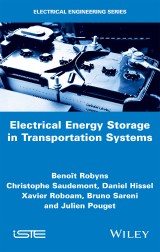Details
Electrical Energy Storage in Transportation Systems
1. Aufl.
|
139,99 € |
|
| Verlag: | Wiley |
| Format: | EPUB |
| Veröffentl.: | 16.08.2016 |
| ISBN/EAN: | 9781119347767 |
| Sprache: | englisch |
| Anzahl Seiten: | 348 |
DRM-geschütztes eBook, Sie benötigen z.B. Adobe Digital Editions und eine Adobe ID zum Lesen.
Beschreibungen
<p>This book deals with the management and valuation of energy storage in electric power grids, highlighting the interest of storage systems in grid applications and developing management methodologies based on artificial intelligence tools. The authors highlight the importance of storing electrical energy, in the context of sustainable development, in "smart cities" and "smart transportation", and discuss multiple services that storing electrical energy can bring.</p> <p>Methodological tools are provided to build an energy management system storage following a generic approach. These tools are based on causal formalisms, artificial intelligence and explicit optimization techniques and are presented throughout the book in connection with concrete case studies.</p>
<p>Foreword ix</p> <p>Introduction xi</p> <p><b>Chapter 1. Issues in Electrical Energy Storage for Transport Systems 1</b></p> <p>1.1. Storage requirements for transport systems 1</p> <p>1.2. Difficulties of storing electrical energy 3</p> <p>1.3. The electrical power supply of transport systems 6</p> <p>1.4. Storage management 8</p> <p>1.4.1. Specifications 11</p> <p>1.4.2. Supervisor structure 11</p> <p>1.4.3. Functional graphs 11</p> <p>1.4.4. Membership functions 12</p> <p>1.4.5. Functional graphs 14</p> <p>1.4.6. Rules 15</p> <p>1.4.7. Indicators 15</p> <p>1.4.8. Optimization of supervisor parameters 16</p> <p>1.4.9. Type-2 fuzzy logic 17</p> <p>1.4.10. Methodologies for the development of energy management in a storage system 17</p> <p><b>Chapter 2. Local DC Grid with Energy Exchange for Applications in Aviation 19</b></p> <p>2.1. Introduction 19</p> <p>2.2. Onboard grid 22</p> <p>2.3. Local DC grid 23</p> <p>2.4. Supervisor design methodology 26</p> <p>2.5. Specifications 27</p> <p>2.5.1. Objectives 27</p> <p>2.5.2. Constraints 27</p> <p>2.5.3. Means of action 27</p> <p>2.6. Supervisor structure 28</p> <p>2.6.1. Input values 28</p> <p>2.6.2. Output values 28</p> <p>2.7. Selection of design tools 29</p> <p>2.8. Identification of different operating states: the functional graph 31</p> <p>2.8.1. General functional graph 31</p> <p>2.8.2. Functional subgraphs 33</p> <p>2.9. Tools 41</p> <p>2.10. Membership functions 41</p> <p>2.11. Operational graph 45</p> <p>2.12. Fuzzy rules 53</p> <p>2.13. Experimental validation 57</p> <p>2.13.1. Supervisor implementation 57</p> <p>2.13.2. Experimental configuration 62</p> <p>2.13.3. Results and analyses 63</p> <p>2.14. Fuzzy supervisor optimization 72</p> <p>2.14.1. Supervisor optimization methodology based on fuzzy rules 72</p> <p>2.14.2. Application at levels N1 and N2 78</p> <p>2.15. Conclusion 92</p> <p><b>Chapter 3. Electric and Hybrid Vehicles 95</b></p> <p>3.1. Introduction 95</p> <p>3.2. Storage technologies in hybrids and EVs 99</p> <p>3.3. Development of EVs and interaction with electric power grids 100</p> <p>3.3.1. Issues in the development of EVs 100</p> <p>3.3.2. Charge of EVs 101</p> <p>3.3.3. Issues in the electric power grid integration 102</p> <p>3.4. EV charging supervision 103</p> <p>3.4.1. Introduction 103</p> <p>3.4.2. EV charging models 104</p> <p>3.4.3. Electric power distribution grid 108</p> <p>3.4.4. Supervision 112</p> <p>3.4.5. Results 122</p> <p>3.5. The reversible charge of EVs 125</p> <p>3.5.1. Introduction 125</p> <p>3.5.2. Vehicle-to-grid and contribution of the reversible charge to the electric power grids 125</p> <p>3.5.3. Vehicle-to-home and contribution of the reversible charge to buildings 127</p> <p>3.6. Configurations and operating principle of HV 128</p> <p>3.6.1. Hybridization levels 128</p> <p>3.6.2. Configurations of power trains 129</p> <p>3.7. Energy management in a hybrid vehicle 131</p> <p>3.7.1. Introduction 131</p> <p>3.7.2. Fuzzy logic for energy management 132</p> <p>3.7.3. Type-2 fuzzy logic 132</p> <p>3.7.4. Application to the energy management of an EV 139</p> <p>3.8. Conclusion 146</p> <p><b>Chapter 4. Railway System: Diesel–Electric Hybrid Power Train 147</b></p> <p>4.1. Introduction 147</p> <p>4.2. Design of an autonomous hybrid locomotive 151</p> <p>4.2.1. Introduction to the issues in design and energy management within the framework of the PLATHEE project 151</p> <p>4.2.2. Frequency management strategy 157</p> <p>4.2.3. Importance and processing of railway assignments 163</p> <p>4.2.4. Sequential design: from dimensioning to analysis 171</p> <p>4.2.5 Implementation of the PLATHEE demonstrator 200</p> <p>4.3. Conclusion 216</p> <p>4.4. Exercise: definition of the energy requirements in the railway sector and application of storage to electric traction 217</p> <p>4.4.1. Kinematic study of a train 218</p> <p>4.4.2. Study on energy profile of a train 227</p> <p>4.4.3. Basic design and comparison of energy storage system technologies for railway applications 240</p> <p>4.5. Appendices 249</p> <p>4.5.1. Technical characteristics of storage sources and components carried on board the PLATHEE 249</p> <p><b>Chapter 5. Railway System: Hybrid Railway Power Substation 255</b></p> <p>5.1. Introduction 255</p> <p>5.2. Hybrid railway power substations 260</p> <p>5.2.1. Issues in the railway electrification system 260</p> <p>5.2.2. The HRPS solution 265</p> <p>5.2.3. State-of-the-art of the HRPS 267</p> <p>5.3. Energy management in an HRPS 279</p> <p>5.3.1. Methodology 279</p> <p>5.3.2. Technical specifications 280</p> <p>5.3.3. Supervisor structure 283</p> <p>5.3.4. Determination of the functional graphs of the short-term supervisor 284</p> <p>5.3.5. Membership functions 289</p> <p>5.3.6. Determination of functional graphs 291</p> <p>5.3.7. Fuzzy rules 295</p> <p>5.3.8. Performance indicators 295</p> <p>5.3.9. Modeling and results 298</p> <p>5.3.10. Energy management optimization 302</p> <p>5.4. Experimentation of an HRPS and sensitivity analysis 309</p> <p>5.5. Railway smart grid perspective 316</p> <p>5.6. Conclusion 318</p> <p>5.7. Acknowledgments 318</p> <p>Bibliography 319</p> <p>Index 329</p>
<p><b>Benoit ROBYNS</b>, Hautes Etudes d'Ingénieur, Lille, France</p> <p><b>Christophe SAUDEMONT</b>, Hautes Etudes d'Ingénieur, Lille, France</p> <p><b>Asma MERDASSI</b>, Hautes Etudes d'Ingénieur, Lille, France</p> <p><b>Daniel HISSEL</b>, Université de Franche-Comté</p> <p><b>Xavier ROBOAM</b>, Institut National Polytechnique de Toulouse</p> <p><b>Bruno SARENI</b>, Institut National Polytechnique de Toulouse</p> <p><b>Bruno FRANCOIS</b>, Ecole Centrale de Lille</p>


















